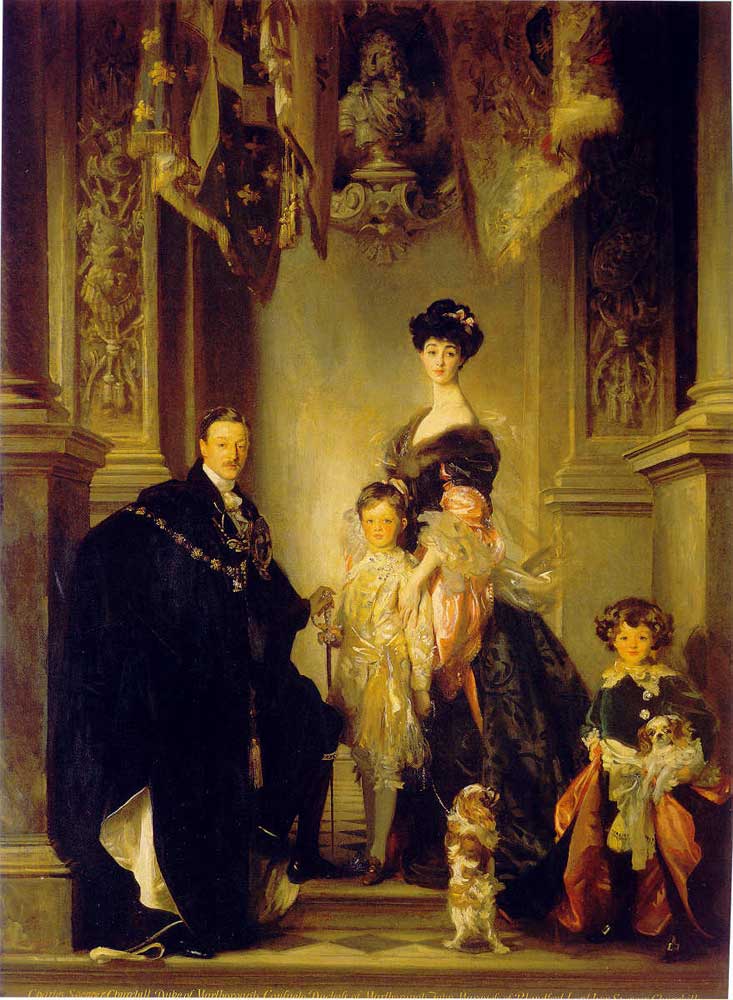Not a Dwelling
“From my window I overlooked a pond in which a former butler had drowned himself. As one gloomy day succeeded another, I began to feel a deep sympathy for him.” -Consuelo Vanderbilt upon moving into Blenheim Palace.
Blenheim Palace (opened 1950)
Woodstock, Oxfordshire, England
During the Gilded Age, the mating dance between American heiresses and the British aristocracy replaced matters of the heart with matters of money. In the prosaic process, the daughters of the nouveaux riche received titles; their cash-strapped husbands received an infusion of funds. Downton Abbey’s Cora Crawley was a husband-hunter whose calling was to transform to Lady Crawley. Cora’s nonfictional counterpart was Consuelo Vanderbilt, the chatelaine of Blenheim Palace.
Standing guard in the front of Manhattan’s Grand Central Station is America’s counterpart to Egypt’s Ozymandias: a twelve-foot, four-ton, bronze statue. The likeness is of “Commodore” Cornelius Vanderbilt, the son of an impoverished farmer, who had constructed the original Grand Central Depot, and the New York Central Railway. His son, William, Consuelo’s father, wrote, “Inherited wealth is a real handicap.” He had the handicap of inheriting $90 million.
As soon as Alva heard the words, “It’s a girl,” she had marital aspiration for her only daughter. To keep Consuelo under her thumb, Alva used a riding crop on the child’s legs whenever she showed a streak of independence. Another childhood torment was Consuelo wore a steel orthopedic corset to ensure an erect posture. While her brothers, William Kissam II and Harold Stirling, attended school, three governesses tutored Consuelo in the Vanderbilt’s palatial 660 Fifth Avenue, Petit Chateau, modelled after a sixteenth-century French estate. The pale limestone was in marked contrast to the neighboring brownstones. The front door was a replica of the Ghiberti bronze doors in Florence. An 80-foot-long dining room held two colossal Renaissance fireplaces, and a stained-glass window depicted Henry VIII and Francis I. Adorning the walls were Rembrandt’s “Man in Oriental Costume”, and Gainsborough’s “Mrs. Elliot”. François Boucher’s Toilet of Venus, displayed in Alca’s boudoir, had hung in the boudoir of Madame de Pompadour. A secretaire was once the possession of Marie Antoinette. 
The five-foot-eight Consuelo, (whose erect posture made her seem taller), turned heads with her classic features and cascade of dark hair. At her debut at the Paris residence of the Due de Gramont, she was the sun around which suitors gravitated, one of whom was the future French president, Paul Deschanel. (The belle received five marriage proposals). The heiress spent summers at the Vanderbilt “cottage” in Newport, Rhode Island, where their neighbors bore the names Astor and Morgans. (The mansion-museum is open for tours). Marble House-so named after the amount of the stone used in its construction-carried traces of the White House and Marie Antoinette’s Petit Trianon at Versailles.
Alva’s mantra to her daughter: “I do the thinking. You do as you are told.” As the child of a mega-rich ‘momanager’, the youthful Consuelo was a timid, introverted bookworm, dwarfed by her mother’s shadow. Consuelo’s escape lay with the man she loved, Winthrop Rutherfurd. When Alva learned of their romance, she sent the swain packing. Winthrop, (Winty), was no slouch in the eligible male pool; he was a direct descendant of Peter Stuyvesant, the colonial governor of New York, and John Winthrop, the first governor of Massachusetts. Notwithstanding, Alva aspired for more in a son-in-law. In rebellion, Consuelo threatened to elope, upon which Alva swore she would shoot the young man. If that were not enough to cool Consuelo’s ardor, her mother feigned a heart attack. Under the double volley, Consuelo caved.
Alva grabbed hold of the matrimonial reins and looked across the pond for a peerage. The concept was in vogue: a quarterly publication held a list of all the eligible, titled, British bachelors-a nineteenth century eHarmony. Cash-for-class liaisons birthed Britain’s Sir Winston Churchill; his father, Lord Randolph Churchill, had proposed to Jennie Jerome forty-eight hours after meeting the Brooklyn-born beauty.
Alva knew if she could pull off the social coup of the century she would earn a spot as one of The Four Hundred, the number of upper strata guests who could fit into Mrs. Astor’s ballroom. Mrs. Astor had snubbed Alva on the basis the Vanderbilts were nouveau riche. Alva’s alliance was a match between the American royal house of Vanderbilt with Charles Spencer Churchill, the ninth Duke of Marlborough. The dour, diminutive, and depressive duke went by the nickname “Sunny” after his title, the Earl of Sunderland. The Lord was the owner of Blenheim Palace whose financial maintenance had been an albatross for every Duke of Marlborough. The mother bridezilla knew the marital merger would leave Mrs. Astor in the dust. Who needed her ballroom if one could mingle with HRH, The Prince of Wales?
The November 6, 1895, Manhattan wedding was the most heralded society gala of the time, an event that would have been comparable to if William, the Prince of Wales, had married Paris Hilton. The forthcoming nuptial had regulated to the back pages news such as the popularity of bloomers as cycling dresses, NY elections, and Cuba’s War of Independence. Sixty members of the orchestra filled the air of St. Thomas Episcopal Church with the strains of Mendelssohn’s Overture to A Mid-Summer Night’s Dream. Three hundred policemen guarded the door to hold back thousands of onlookers. Vogue magazine had devoted pages to the wedding-gown that had a five-yard train, and the white brocade corset that had gold clasps and diamonds. The nupitals had everything-except the bride. She was at home, weeping in her father’s arms, imploring him not to make her go through with the wedding. Still intimated by his ex-wife, and dreading an international scandal, (Queen Victoria had sent a message of congratulations), William delivered Consuelo to the church. Father and daughter arrived twenty minutes late.
When Consuelo walked down the aisle, she carried orchids that had originated in Blenheim’s greenhouses, flowers that had survived the ocean passage in a refrigerated chamber. The couple’s presents were on display, one of which was a string of pearls that had once encircled the neck of Catherine the Great. The queue to view the booty stretched halfway along Fifth Avenue.
As American authors Edith Wharton and Henry James had explored in their novels, the transatlantic unions carried emotional price tags. The honeymoon on the Vanderbilt yacht was no midsummer night’s dream. Consuelo confessed she was in love with Winthrop Rutherfurd; he shared his mistress was Muriel Wilson of Tranby Croft. Marlborough might have cared for Muriel, but his truest love was Blenheim.
The newly anointed Duchess of Marlborough lived in the 170-ro0m palace, the only British one not a royal residence. Consuelo was miserable; she hated the formality that entailed at least four changes of clothes per day. Over eight-course dinners in a magnificent dining-room, an uncomfortable silence reigned between Charles and Consuelo. Despite their mutual antipathy, they fulfilled their duty and had sons John Albert Edward and Ivor. Lore holds that Consuelo coined the phrase, “An heir and a spare.” With the obligation of continuing the dynasty accomplished, the couple embarked on lord and lady adultery. A source of comfort was Charles’ cousin, Winston Churchill, with whom she forced a life-long bond.
Consuelo seamlessly blended into the fabric of British society. Sir James Barrie, the author of Peter Pan, reported, “I would stand all day in the street to see Consuelo Marlborough get into her carriage.” Queen Victoria welcomed the duchess to Windsor Palace. The hostess entertained the Prince of Wales, and the kaiser. She became known as “the democratic duchess” as she deeply cared about the well-being of her forty servants, and the poor who lived on the margins of the estate.
Sought after as guests in England and abroad, Tsar Nicholas II and Tsarina Alexandra invited them to a New Year’s Ball at the Winter Palace. Grand Duke Michael, the tsar’s brother, invited Consuelo to dance a mazurka. In 1918, Bolsheviks assassinated the royal siblings. In 1902, after departing Russia, Consuelo caught a severe cold that left her slightly deaf. His wife’s affliction proved a source of irritation to her husband. Four years later, Consuelo embarked on an affair with the similarly married Viscount Castlereagh, the eldest son of the Marquess of Londonderry, and they planned an assignation in France. At a dinner party in Blenheim, Consuelo mentioned she was heading to Paris to buy her winter wardrobe. An infuriated duke shouted she stood stay there- thus sealing the doom of their dinner party and marriage. To lessen the blow, Winston sent John and Ivor gifts.
Charles married Gladys Marie Deacon, a Boston heiress; Consuelo wed Lieutenant Colonel Louis Jacques Balsan, a Catholic French aviator. The couple built a villa at Eze on the French Riviera and entertained Winston Churchill, George Bernard Shaw, and Charlie Chaplin. Their next residence was a chateau near Paris that included a sanitorium for sick children. When the Germans invaded, the Balsans fled to the south, along with a fleet of vans to transport their ill charges. During the war, the couple settled in New York where Jacques passed away at age eighty-eight. His widow died at the same age, in 1964, one of the last survivors of America’s gilded age- a term coined by Mark Twain. Services were held at St. Thomas Episcopalian Church; the sixty-voice choir sang the anthem, “How Lovely is Thy Dwelling Place.
Consuelo chose internment in a churchyard near Blenheim Palace, close to Lord Ivor. Mourners included her son, the 10th Duke of Marlborough, her grandchildren, Lady Clementine Churchill with her son, Randolph. Sir Winston, at age ninety, was too infirm to attend.
Blenheim Palace: When King George visited Blenheim Palace in 1786, he remarked to Queen Charlotte, “We have nothing equal to this.” Other royals who journeyed to Oxfordshire to see the historic home were the King of Denmark, 1768, The tsar of Russia, 1814, Prince Albert, 1841, Edward VII, 1859. The residence is the only one referred to as a palace that is not owned by the royal family or the Church of England. The eighteenth-century poet Alexander Pope, overwhelmed by the estate’s enormity, “Thanks, Sir, cry’d I, ‘tis very fine/But where d’ye sleep and where d’ye dine?” The same question might be asked by those crossing the threshold of Blenheim into the inner sanctums of the British upper crust. In 1702, John Churchill became the first Duke of Marlborough when Queen Anne awarded him the title and the 2,000-acre estate for his victories against Louis XIV in the Battle of Blenheim. The Duke envisioned a palace that would rival that of the Louis XIV’s Versailles. When John passed away, his widow built the Triumphal Arch to serve as an entrance to the grounds, inscribed with the words, “This gate was built the year after the death of the most illustrious John Duke of Marlborough by order of Sarah his most beloved wife.” Three years later, saw the completion of the 131- foot-tall Column of Victory, a Doric-styled limestone pillar topped by a statue of the 1’st Duke of Marlborough, garbed in the attire of a Roman general.
The museum is an ode to Prime Minister Sir Winston. Visitors can enter his bedroom that retains a red carpet, rose-print wallpaper, and a velvet-cushioned rocking chair. Guests can stroll along the rose garden where Winston proposed to his wife, Clementine. Adolf Hitler ordered his Luftwaffe not to bomb Blenheim as he planned to occupy the premise after he invaded England.
The Long Library, where Winston spend endless hours, is the repository of more than 10,000 books, many over a century old. Looking upon the room are busts of the 1st and 3rd dukes. The Green Drawing Room-so named after the color of the furniture and wall panels-ceiling gleans with the accent of gold. The Red Drawing Room has red wallpaper and furniture made by Thomas Chippendale.
Blenheim objects also recall the American duchess. On display is an ornate cradle, a gift Alva sent her daughter, a replica of the one in the Dodge’s Palace in Venice. John Singer Sargent painted a portrait of their family and their two dogs. Charles is seated that camouflages the fact his wife towered over his five-foot two frame.
Blenheim objects also recall the American duchess. Consuelo harbored such an antipathy to Charles that she used a large silver vessel that bore the carving of the Battle of Blenheim as the centerpiece for their dining table. In addition to the husband-blocker, there is a portrait of Consuelo against a red-velvet background that Alva had commissioned in Paris, that had originally hung in Marble House.
The current owner, the 11th Duke of Marlborough, John George Vanderbilt Henry Spencer-Churchill, moved in Princess Margaret’s circle, and there was speculation of a 1948 romance. In addition to opening Blenheim as a home museum, the 11th Duke of Marlborough, John George Vanderbilt Henry Spencer-Churchill, rented it out for venues such as for a Barry Manilow pop concert, and Sylvester Stallone’s wedding. In 1998, he built the 1.8-acre Marlborough hedge maze, the world’s second largest, inspired by the Grinling Gibbons carvings etched on the colonnades. He also restored the Rose Garden created in the nineteenth century. A short walk from the palace, across the Grand Bridge, stands the Harry Potter Tree, a Cedar of Lebanon that served as the setting for the 2007 Harry Potter and the Order of the Phoenix. The site also appeared in the films The Avengers, Gulliver’s Travels, and The Legend of Tarzan.
In 2017, an antiques expert spied an unusual plant holder, filled with tulips. Carvings adorned the “flowerpot” and displayed a drunken Dionysius leaning on a satyr. He recognized the antique was part of a Roman sarcophagus dating from the second century A.D. The duke moved the reliquary inside.
The stately met the profane in 2023 when thieves absconded with the palace’s 18-karat gold loo whose theft caused a minor flood. The fully functioning toilet-estimated at $5.9 million- was an exhibit by the Italian artist Mautizio Cattelan, entitled “America.”
The last lines of the Alexander Pope poem, applied to the years Consuelo spent at Blenheim, “I find by all you have been telling/That’ tis a house, but not a dwelling.”
The Window of Her World: From her palace’s windows, Consuelo could have reminisced about her palatial homes that bookmarked her life, alluded to in her memoir, The Glitter and the Gold


